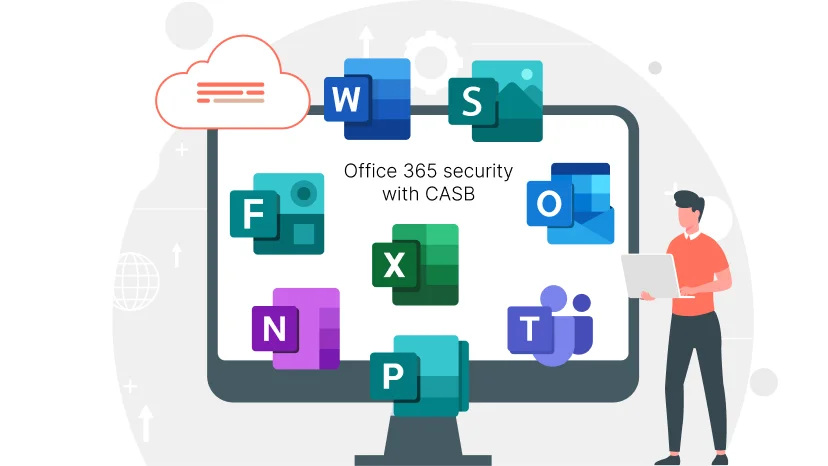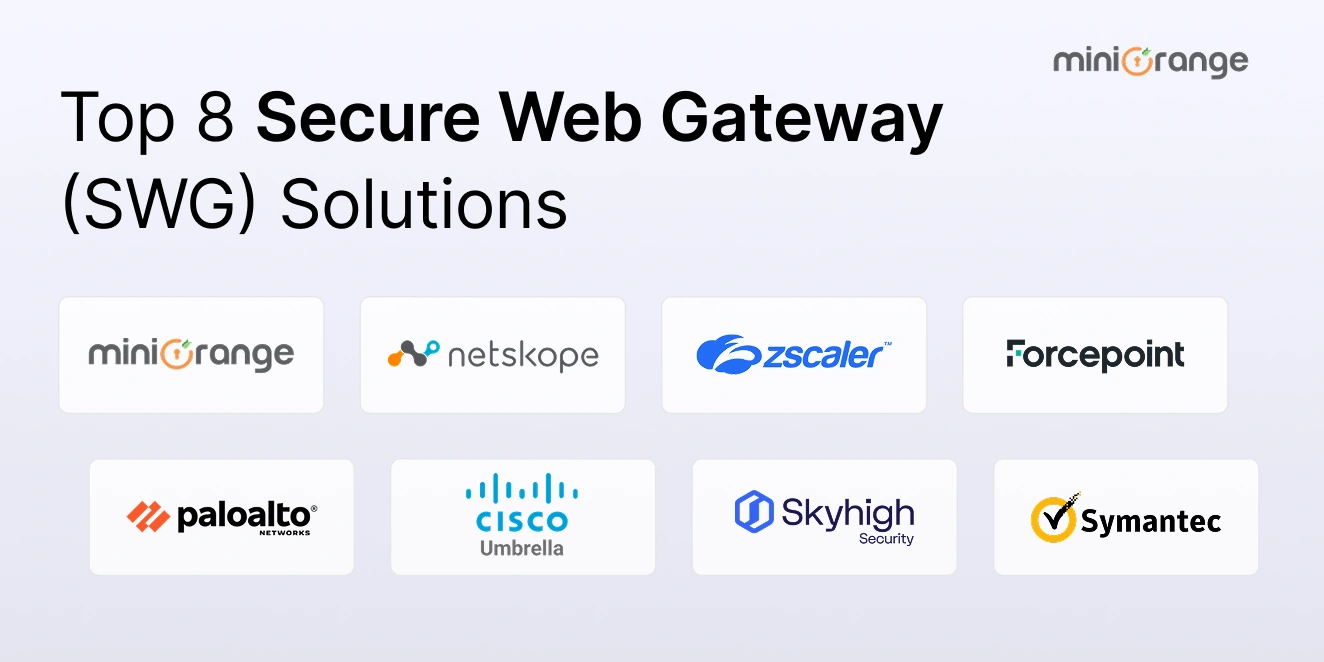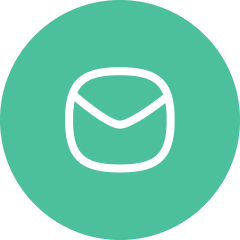In this blog, we'll break down what is DSPM security, how it works, why it's essential for modern enterprises, and how it helps reduce data exposure risks in real time. Your data is everywhere, across clouds, apps, and devices. But is it safe? Discover how DSPM brings order, protection, and clarity to your security teams and business.
What is DSPM (Data Security Posture Management)?
Your business data is stored on multiple cloud platforms like Google Drive, Microsoft OneDrive, Dropbox, Slack, and Salesforce. While this setup offers flexibility and collaboration, it also creates a major blind spot. For example, your HR data is in Google Drive, customer contracts in Dropbox, marketing files in Slack, and product roadmaps floating in emails. If you don't know where your data is, how can you protect it?
Well, Data Security Posture Management (DSPM) can be one of the best approaches to data protection in this scenario, It helps businesses:
- Discover and classify sensitive data wherever it lives
- Assess exposure risks and compliance gaps
- Automatically remediate vulnerabilities
According to Nasscom, over 80% of organizations report a surge in cloud-related attacks. DSPM directly addresses this challenge by offering visibility and actionable insights.
Unlike traditional data security tools that only protect endpoints or monitor activity, DSPM provides a complete view of your data's posture. It scans, maps, classifies, and prioritizes what matters most, so you can act decisively.
Companies in every industry, from healthcare to fintech to eCommerce, are adopting DSPM to stay ahead of threats and meet increasing regulatory demands.
Components of DSPM
The effectiveness of any DSPM tool lies in its core components, which are:
1. Data Discovery
- Multi-cloud storage: AWS, GCP, Azure
- On-prem systems
- SaaS platforms: Google Workspace, Salesforce, Slack
- Hybrid environments
Using APIs, DSPM detects data in transit and at rest, even in obscure locations.
2. Data Classification
- PHI (protected health info)
- Intellectual property (IP)
- PII (personally identifiable information)
- PCI (payment card information)
Classification helps prioritize protection and enforce correct access levels.
3. Risk Assessment
- Misconfigurations (e.g., unencrypted storage, public buckets)
- Non-compliant data usage
- Insider risks and anomalous behavior
- Overexposed permissions
All vulnerabilities are ranked based on severity and business impact.
4. Remediation & Prevention
- Fix problems quickly
- Revoke excess privileges
- Continuously improve posture over time
- Enforce encryption
Why is DSPM Important?
In the earlier days, your company's sensitive data stayed on-premises. It sat behind firewalls and monitored networks.
But now?
- Your HR team is using Google Drive.
- Developers are spinning up cloud instances on AWS.
- Sales is storing customer data in CRMs like HubSpot or Salesforce.
- Someone just shared a client file on a Slack channel—without encryption.
So, your sensitive data is everywhere. And with so much movement, even the best security teams can lose track of files.
Moreover, with the rise of cloud computing, AI, and remote work, new risks have emerged—risks that traditional tools may not catch.
Here, SaaS security posture management (SSPM) can use used as a critical layer that provides continuous visibility into how your SaaS platforms store, process, and share data, making it easier to identify misconfigurations and prevent data exposure.
How does DSPM Work?
DSPM solutions are agentless. That means you don't have to install extra software on every system or endpoint to make it work—saving your team time and reducing system overhead.
Here's how they typically operate in four clear steps:
Step 1. Data Discovery – Find Your Data First
Before you can protect your data, you have to know where it lives. This is where DSPM data security tools really shine.
It automatically scans your entire IT landscape—from cloud platforms to SaaS apps—to identify sensitive data that may be hidden, forgotten, or scattered. This includes:
- Public, private, and hybrid cloud environments
- Major cloud platforms like AWS, Microsoft Azure, Google Cloud, and tools like Salesforce, Dropbox, or Slack
- All types of data—structured data in databases, unstructured data in files and documents, object storage, data lakes, and more
Step 2. Data Classification – Understand What You're Protecting
Once DSPM solutions discover your data, the next job is to figure out what kind of data it is—and how sensitive it might be.
This step involves data classification, where the tool evaluates:
- Is the data personally identifiable information (PII) like names, social security numbers, or payment details?
- Is it protected under regulations like GDPR, HIPAA, CCPA, or industry-specific policies?
- Who currently has access to this data? Are those permissions necessary or too broad?
- Is the data encrypted or sitting in plain text?
By organizing and labeling your data based on sensitivity, usage, and compliance needs, DSPM helps you prioritize protection and avoid accidental exposure.
Step 3. Risk Assessment & Prioritization – Spot and Sort the Real Threats
Next comes the risk check. Data security posture management solution evaluate your data landscape for vulnerabilities that could lead to a breach, a compliance violation, or insider misuse.
Here's what they look for:
- Misconfigurations – For example, if a cloud bucket storing sensitive data is left public by accident, or encryption is turned off
- Overentitlements – Too many people having access to sensitive data they don't actually need
- Data flow tracking – Watching how data moves between systems and who interacts with it, which helps spot unauthorized access or unusual behavior
- Compliance issues – Are you meeting GDPR, HIPAA, CCPA, or internal policy requirements for data handling?
This step is like a full-body scan for your data environment. And it doesn't just throw alerts—it prioritizes risks based on how critical the data is, so your team knows where to focus first.
Step 4. Remediation and Prevention – Fix the Problems & Stay Ahead
Finally, it's not enough to just know where the issues are. DSPM solutions also help remediate them—and prevent them from happening again.
Here's how:
- Real-time dashboards and alerts keep your security team informed and in control
- It provides clear remediation steps or automated fixes—like revoking excess access, encrypting exposed data, or securing misconfigured cloud storage
- DSPM can even integrate with developer workflows, catching security issues during the DevOps process before they ever reach production
- It continuously scans for new data or emerging risks, so you're always one step ahead
In short, Data security posture management doesn't just clean up your data posture once—it's built to monitor, enforce, and evolve with your data.
Benefits of DSPM for Modern Workplaces
1. Full Data Visibility
Most companies fail to track when teams upload, share, or store files across different app like Slack, Google Drive, AWS, or Microsoft 365. DSPM automatically scans and maps all your data. Whether it’s stored in an email attachment or left in an old cloud folder, you’ll have a clear picture of everything.
2. Better Access Control
Imagine an intern having access to your company’s financial records. Or a customer report being available to your entire team when only two people need it. DSPM helps you fix that. It checks who has access to what and flags anything that looks risky, like publicly shared files or over-permissioned user roles. This way, only the right people can access sensitive data.
3. Ongoing Risk Assessment
Your business data often gets emailed, downloaded, uploaded, copied, and edited constantly. DSPM keeps an eye on your environment 24/7. If a file suddenly becomes publicly accessible or someone downloads a sensitive doc to an unsecured device, DSPM sends an alert and also helps you stay compliant with laws like GDPR, HIPAA, and CCPA.
4. Faster Threat Response
DSPM helps by identifying the most sensitive data at risk. It can send alerts, prioritize critical issues, and even trigger automated actions like revoking access or fixing misconfigurations.
5. Stronger Security Policies
DSPM helps enforce company-wide rules for how data should be stored, accessed, shared, and deleted. Whether someone uploads data to the cloud or shares it with a third party, DSPM ensures your policies are applied in real-time, so nothing slips through the cracks.

DSPM Best Practices
1. Start with Complete Data Discovery
Make it a priority to scan your entire cloud and SaaS ecosystem, tools like Slack, Google Drive, Salesforce, AWS, and Dropbox, for sensitive data. This step helps you get a baseline view of where your data lives, how it flows, and where it’s most vulnerable.
2. Classify Your Data Based on Sensitivity
Financial reports, customer PII, employee health records, these deserve higher protection than project drafts or meeting notes. By tagging and labeling data based on how sensitive or regulated it is, you’ll be able to apply the right controls and prioritize responses when things go wrong.
3. Implement Least Privilege Access Controls
Ensure users, apps, and third parties only have access to the data they absolutely need to do their job, no more, no less. Overexposure is one of the top causes of data leaks, especially in SaaS environments where roles and permissions change quickly.
4. Continuously Monitor for Risky Behavior
DSPM tools should run 24/7, automatically detecting abnormal behaviors, like unusual file downloads, policy violations, or data being shared outside your domain. This proactive monitoring helps your security team act before small issues become major breaches.
5. Align DSPM with Regulatory Compliance
A strong DSPM setup should automate compliance mapping, generate reports, and help ensure that sensitive data doesn’t end up where it shouldn’t.
6. Integrate DSPM with Existing Security Stack
Integrate DSPM with your identity providers, CASB, DLP, EDR, or SIEM tools. This creates a unified view of your cloud and SaaS security posture, and allows for faster, smarter decision-making.
7. Review & Refine Regularly
Set a schedule to regularly review your DSPM strategy, audit logs, policy effectiveness, and tool performance.
DSPM Integrations
1. IAM (Identity and Access Management)
Identity and Access Management (IAM) solutions control who has access to what within your organization—ensuring only the right people can reach sensitive resources. It brings data-centric context to IAM by identifying what sensitive data exists and who has access to it.
It helps you:
- Automatically flag over-privileged users
- Detect access anomalies (e.g., a marketing user accessing finance data)
- Automate access reviews and policy updates
So instead of just managing access broadly, DSPM helps you apply least-privilege principles to your most critical data.
2. CASB (Cloud Access Security Broker)
Cloud Access Security Broker (CASB) solution monitors and controls activity across cloud apps, ensuring policies are enforced across SaaS, IaaS, and PaaS. While CASB focus on cloud usage and compliance, DSPM provides deep data-level insights. Together, they offer:
- Granular visibility into what sensitive data exists in which cloud app
- Real-time alerts if that data is shared externally or violates policy
- Contextual risk analysis by linking user behavior with sensitive data
This combo helps prevent shadow IT risks and improves data governance across your cloud footprint.
3. EDR (Endpoint Detection and Response)
EDR solutions monitor endpoints (like laptops, phones, and servers) to detect malware, ransomware, and suspicious behavior. DSPM connects the dots between endpoint threats and sensitive data. For example:
- If malware hits a device, DSPM identifies whether that device had access to PII or financial data
- Flags data exfiltration attempts in context (e.g., USB transfer of sensitive files)
- Helps prioritize incidents based on data sensitivity
This results in faster, smarter threat responses—so your team knows what's really at stake. Learn more about Endpoint Detection and Response (EDR)
4. SIEM (Security Information and Event Management)
SIEM platforms collect and correlate logs and events across your infrastructure to detect threats and generate alerts. It is great at identifying unusual activity, but often lack data awareness. DSPM enhances SIEMs by:
- Feeding real-time insights on where sensitive data resides
- Adding risk scores based on data sensitivity
- Helping analysts understand which data is involved in an alert
This makes alerts more meaningful and enables data-aware incident investigation.
5. DLP (Data Loss Prevention)
Data Loss Prevention (DLP) tools prevent unauthorized sharing or transfer of sensitive information—like blocking a credit card file from being emailed. DSPM takes DLP to the next level by ensuring that DLP policies are accurately aligned with your real data inventory. It helps:
- Discover sensitive data DLP tools may miss
- Suggest policy updates based on newly discovered data
- Reduce false positives by classifying data precisely
In short, DSPM ensures that your DLP rules actually reflect your current data landscape.
6. IDPS (Intrusion Detection and Prevention Systems)
IDPS monitors network traffic for suspicious activity and blocks potential threats. While IDPS focuses on network-layer behavior, DSPM adds data-layer intelligence. It can:
- Highlight if an attack path leads to sensitive data
- Add data risk indicators to traffic anomalies
- Inform IDPS rules based on where critical data is stored
This lets you add data-aware threat detection into your network defenses.
7. Security Analytics & AI Tools
These tools analyze massive amounts of security data using machine learning to detect advanced threats and patterns. DSPM provides deep visibility into sensitive data, which makes AI-driven tools smarter. For example:
- AI can factor in data sensitivity to better prioritize threats
- DSPM gives structured and unstructured data context for behavior analysis
- Enhances insider threat detection by mapping unusual user activity to sensitive data access
With DSPM in the mix, AI tools get more relevant context and can produce higher-quality, actionable insights.

Difference between DSPM with other cloud security tools
It's easy to confuse DSPM with CSPM, and CIEM . Here's how they're different:
DSPM (Data Security Posture Management)
DSPM is all about visibility, classification, risk assessment, and protection of sensitive data, whether it's sitting in a database, cloud storage bucket, or flowing through SaaS tools like Salesforce or Slack.
For Example: You want to make sure no customer PII is sitting unprotected in your cloud storage. DSPM helps you discover it, classify it, and secure it—automatically.
CSPM (Cloud Security Posture Management)
If DSPM is all about data, CSPM is all about your cloud setup. CSPM tools are designed to monitor your cloud infrastructure for misconfigurations (e.g., public S3 buckets, open ports), compliance gaps (e.g., failing PCI DSS, HIPAA checks), and vulnerabilities in how cloud services are set up.
For Example: Your development team accidentally made a storage bucket public. CSPM spots misconfiguration and alerts you before it becomes a security incident.
Know more about Cloud Security Posture Management (CSPM).
CIEM (Cloud Infrastructure Entitlement Management)
CIEM takes a deep dive into who has access to what in your cloud environment. It's like your permissions auditor—it helps you ensure that users (and services) don't have more access than they need, there are no risky permission escalations or dormant access rights and access policies follow the principle of least privilege.
For Example: An old intern's cloud account still has admin rights weeks after leaving the company. CIEM detects this and recommends revoking the access.
| Tool | Focus Area | Key Function |
|---|---|---|
| DSPM | Data | Finds, classifies, and protects sensitive data |
| CSPM | Cloud Infrastructure | Detects cloud misconfigurations and compliance gaps |
| CIEM | Access Permissions | Manages and audits user entitlements |
Why DSPM matters for modern security teams
1. Data Is No Longer Centralized
Data now resides across countless SaaS apps, cloud services, and endpoints, often without security oversight. DSPM gives you complete visibility into where sensitive data lives and who can access it.
2. Traditional Tools Can’t Keep Up
Perimeter-based security like firewalls and basic DLP can't follow data as it moves across platforms. DSPM secures the data itself, regardless of where it travels or how it’s shared.
3. Security Teams Are Overloaded
Security teams are bombarded with alerts and stretched thin. DSPM automates risk detection and remediation, freeing up time to focus on real threats.
4. Compliance Is Getting Stricter
New data privacy regulations demand full visibility and control over sensitive information. DSPM helps meet compliance standards with automated data discovery and policy enforcement.
5. Proactive Protection Is Critical
Most breaches stem from misconfigurations or accidental data exposure, not direct attacks. DSPM identifies and fixes these risks before they become security incidents.
6. Complements SSPM Perfectly
While SSPM secures your SaaS configurations, DSPM protects the data within those apps. Together, they deliver full-spectrum SaaS security posture management.
7. Data Is the New Perimeter
Remote work has made traditional network boundaries obsolete. DSPM treats your data as the new perimeter and protects it wherever it goes.
To Sum Up
A DSPM solution gives your organization the visibility, control, and automation needed to protect sensitive data in real time. Whether you're dealing with regulatory requirements or zero-trust policies, DSPM security equips your team to stay ahead of threats—not just react to them.
If you're still wondering how to get started with a DSPM data security posture management framework tailored to your infrastructure, we're here to help.
Reach out to our experts at info@xecurify.com to explore how miniOrange can help you implement the right DSPM data security strategy for your business.




Leave a Comment